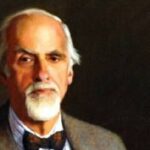Sigmund Freud Theory of Personality

Sigmund Freud Theory of Personality: this article provides a practical explanation of the Sigmund Freud Theory of Personality. This article highlights besides what this theory is also the development of Psychological Stages and Libido, the Talk therapy, the dream theory and how it works with defensive Mechanisms. After reading this article, you’ll understand the basics of this personality and Child Development theory. Enjoy reading!
What is the Sigmund Freud Theory of Personality and Child Development?
The psychoanalytic theory of Sigmund Freud, or Freudian theory, is a theory about personality organisation, the dynamics between the various stages of personality development, and the impact this has on the development of human beings’ libido: de dynamics of psychosexual development.
The psychoanalytic theory and other works of Sigmund Freud were published in the late 19th century and have since been frequently refined and altered. Sigmund Freud first worked on analyses within his physiological studies, but halted these studies when he transferred his focus to studying the human mind and its accompanying attributes.
His study emphasised the recognition and impact of childhood events and how these could affect the functioning of adults. His studies formed the basis for modern-day psychotherapy.
For this reason, Sigmund Freud is considered the father of psychiatry. The most far-reaching and famous of his many accomplishments is probably the Freudian personality theory.
Sigmund Freud, born in Freiberg, the current Czech Republic, is also known for his theory on the interpretation of dreams. He believed dreams represent a disguised fulfillment of a repressed wish. Freud’s work is considered controversial by many, especially his thoughts on the Oedipus complex, penis envy and death instincts.
Josef Breuer was Sigmund Freud’s mentor for many years. He contributed to the development of psycho therapy and is considered the founder of psychoanalysis.
After his death, the Sigmund Freud Theory has often been the focus of other psychoanalysts and was repeatedly adapted and subjected to different interpretations. Despite the fact that this theory is widely valued, the Sigmund Freud Theory is also criticised by many and remains a controversial topic to this day due to its relevance.
Sigmund Freud Theory of Personality: ID, Ego, and Superego
According to the Freudian Theory of the psyche, human personality is highly complex and consists of multiple components. In his theory, he subdivided personality into three elements: the id, the ego and the super ego.
The id is the primitive and instinctive part of the mind that includes sexual and aggressive motivators and hidden memories. The super ego functions as a moral conscience and the ego is the realistic element that mediates between the desires of the id and the super ego.
These elements work together to create complex human behaviours. These don’t just provide a unique, individual contribution to personality, but interact and influence each other in a way that exerts a powerful impact on each individual. The three elements take centre stage more strongly during certain moments in life compared to others.
ID
The id, the most primitive part of the three structures, refers to the irrational needs and demands of a person. In no way does it take into account the current situation, but rather focuses on immediate satisfaction and fulfilment of physical basic needs and drives.
If a car-lover sees a beautiful car drive by, the id would immediately desire to own it. It doesn’t take into account that it would be illegal to simply take this car, it’s only concerned about the fact that the person wants this car.
A practical and beautiful side of the id is that a baby starts to cry when it’s hungry. When the baby is fed, the id’s demand is fulfilled, and the baby stops crying.
Ego
Contrary to the instinctive id, the ego is the rational and pragmatic part of our personality. It’s less primitive than the id and is both partly conscious and unconscious. The ego develops and becomes active when individuals come into contact with other people. According to the Sigmund Freud Theory, the ego helps to fulfil the id, taking into account the reality of the situation.
When the same person sees a beautiful car drive by, the ego mediates between the id and the super ego and decides to save up to buy the car rather than take it.
If that means this person must save up for another ten years, that’s the sacrifice that must be made to fulfil the desire. The ego itself doesn’t have any realisation of right or wrong; it’s simply about the desire being fulfilled without the id or the ego itself suffering from this.
Super Ego
The super ego, that begins to develop from the age of five, is often the third phase that encompasses the moral limitations. These moral limitations are often imposed by parents or caregivers and are known as the ‘conscience’ or ‘moral compass’.
If the id were stronger than the super ego, the person in our example would steal the beautiful car without any scruples. Afterwards, however, the super ego would make the person experience shame and cause them to feel guilty about the action.
The super ego functions to perfect and civilise human behaviour. If properly developed, it ensures that unacceptable impulses of the id are suppressed. The super ego is present in the conscious mind, unconscious mind, pre-conscious and subconscious parts of the mind.
Sigmund Freud Theory: development of Psychological Stages and Libido
In the repressive Victorian society Sigmund Freud was a part of, women were expected to suppress their sexual needs.
In many cases, this led to a neurotic disorder. Freud attempted to understand the nature and various forms of these disorders and began his research. He wanted to understand what the wishes and desires of the patients were, their experiences of love, shame, hatred, guilt, fear and how they coped with these emotions.
This led to one of the most controversial studies of its kind and the most controversial of all Sigmund Freud theories. He discovered several developmental stages people go through from birth and through which they develop a libido.
The first phase starts from birth and ends approximately after the first year. During this phase, the child tests everything with its mouth, the first part of the body that’s developed.
When a child is unsuccessful during this phase and therefore becomes dissatisfied, Sigmund Freud believes he’ll be characterised by pessimism, suspicion and sarcasm later in life. The person reduces feelings of fear or tensions by chewing the tops of pens or excessively chewing gum, for instance.
The second phase starts after the first year and lasts until the third year. Sigmund Freud believed that the primary focus of the libido in this phase lies on controlling the bladder and bowel movements. For this reason, toilet training is the most important part of this phase.
According to the Sigmund Freud Theory, success during this stage depends on the way parents handle toilet training.
Parents who encourage and reward their children at the correct moments help the child to develop faster into a competent, productive and creative person later in life. However, there are also parents who punish or ridicule their children during this period.
These children have a higher chance of negative outcomes. Parents with a too lenient approach might cause their children to develop a messy, wasteful or destructive personality. Parents who are too strict or who start toilet training too soon could cause their children to become strict, orderly, obsessive or rigid.
The third phase occurs between the fourth and sixth life year of a child. Here, the child gets to know himself and his body. This could be expressed in making corny jokes. Parents’ response to this behaviour greatly influences the outcome of the fixation on this.
During the fourth phase, from the sixth year of life until puberty, the libido is suppressed and kept dormant. Usually, children attend school during this phase and they start to worry about making friends, finding hobbies and developing other interests. The super ego continues to develop during this phase, while the id is suppressed.
The last phase takes place from puberty until death and is also the period during which young adults become fertile. The start of puberty means that the suppressed libido once again becomes active.
From this point on, according to the Freudian theory, the ego and super ego have been fully formed and are fully functioning. Younger children are governed by the id, immediate fulfillment of the most primary needs, while teenagers in the genital phase are capable of balancing basic drives and abnormal demands with reality and social standards.
Sigmund Freud Theory of Personality and the element of Talk therapy
One of the most valuable elements of Sigmund Freud theories and works, is his concept of talk therapy: the idea that by talking about problems, the problems can be alleviated. Talk therapy is also known as psychoanalytic therapy, and is a form of therapy based on Freud’s theory.
Freud’s interest in talk therapy and the unconscious mind arose when, through close friend Josef Breuer, he came into contact with a woman known as Anna O. Her real name was Bertha Pappenheim. She suffered from what was then known as hysteria: attacks of hallucinations, blurred vision and partial paralysis.
Discussing her experiences with Breuer gave her relief, and after some time she herself spoke of talk therapy as the ‘talking cure’.
Anna O, or Bertha Pappenheim and Freud never met, but Freud often talked about her situation with Breuer.
This form of therapy investigates how unconscious feelings and thoughts influence behaviour and how past experiences can contribute to present experiences and actions. The interpretation of dreams also plays an important role in this.
Sigmund Freud dream theory
Dreams during the different sleep phases have an important purpose. The most vivid dreams occur when a person is in REM-sleep. REM stands for Rapid Eye Movement. These are the dreams that are most likely to be remembered. Dreams also occur during non-REM sleep, but these dreams are often more general and are not always remembered.
According to Sigmund Freud, dreams reflect the unconscious mind. The Sigmund Freud dream theory suggests that dreams represent the unconscious desires of humans, as well as thoughts, wish fulfillment and motivations. According to Freud, people are driven by conscious and unconscious desires, such as sexual instincts and aggressive instincts.
Sigmund Freud Theory and defensive Mechanisms
The Sigmund Freud Theory of Personality and Child Development describes that the role of the ego is to find balance between the demanding id and the super ego. Healthy individuals are capable of doing so, but there are cases where disruptions have occurred in the various psychological developmental stages and the development of the libido.
This might result in personality problems. Although this could have far-reaching consequences, there are various mechanisms that could either function as protective factors or be negative consequences of disrupted development. Examples of these are:
Displacement
When a person got into a discussion at work and comes home feeling frustrated, it’s possible this frustration is taken out on this person’s partner.
Projection
In a weighty argument, an individual may experience he’s about to lose the argument, making him look stupid. A possible reaction is that this person calls the other stupid, while he’s the one who’s losing the argument.
Sublimation
An aggressive person knows, whether subconsciously or consciously, that hitting people for no reason isn’t a good idea. Exercising could be a means to convert these emotions into something constructive.
Now it’s your turn
What do you think? Do you recognise the explanation about igmund Freud Theory of Personality and Child Development? What do you believe are factors that contribute to a healthy psychological development? Or what do you believe are factors that could disrupt this? What’s your opinion on the Freudian theory?
Share your experience and knowledge in the comments box below.
More information
- Freud, S., & Bonaparte, P. M. (1954). The origins of psychoanalysis (Vol. 216). London: Imago.
- Blum, G. S. (1949). A study of the psychoanalytic theory of psychosexual development. Genetic Psychology Monographs.
- Simon, W., & Gagnon, J. (1969). Psychosexual development. Trans-action, 6(5), 9-17.
How to cite this article:
Janse, B. (2018). Sigmund Freud Theory of Personality. Retrieved [insert date] from Toolshero: https://www.toolshero.com/psychology/sigmund-freud-theory/
Original publication date: 03/13/2018 | Last update: 07/04/2023
Add a link to this page on your website:
<a href=”https://www.toolshero.com/psychology/sigmund-freud-theory/”>Toolshero: Sigmund Freud Theory of Personality</a>













2 responses to “Sigmund Freud Theory of Personality”
Very useful and informative. Thank you!
Best topics for learning and to make notes.